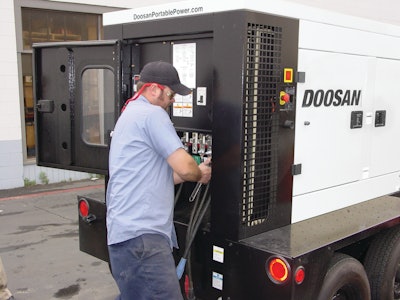
Generators come in all sizes and configurations, ranging from the smaller 1,000-watt hand-held models to large 2-megawatt units. Typically, generators used to provide power at construction sites will range in size anywhere from 25 to 600 kilowatts (kW), and according to John Garcia, manager generator development Americas for Doosan Portable Power, accurately calculating power needs is critical to generator safety.
“Minimal thought given to power needs on any jobsite or event can damage equipment and pose a major safety risk,” Garcia says. “Properly sizing a generator can be complex, which is why we recommend consulting a power generation specialist before selecting a model for a specific application.
Common safety concerns
An undersized generator will have an insufficient power output that can cause the unit to fail. This can damage not only the generator, but also the equipment the generator is powering. Conversely, a generator that’s oversized — i.e., the application doesn’t pull enough power to allow the unit to run at optimal capacity — is likely to result in wet-stacking.
“Wet-stacking occurs when diesel fuel doesn’t burn at an appropriate temperature and begins to clog valves and fuel injectors,” Garcia explains. “If this continues, the engine loses torque and cannot maintain enough horsepower to produce the necessary wattage to power the applications.”
While generators are not all that difficult to operate, setting one up and distributing the power to all the equipment being powered requires a skilled, licensed electrician. Electricians have the knowledge of what the load requirements are for specific equipment, how to properly hardwire the connections and position the selector switch at the phase needed for the application requirements.
Not all electrical systems are powered by the same type of voltage, Garcia explains. Equipment can either require single-phase or three-phase power.
“More than 90 percent of the time, equipment will require single-phase voltage on a jobsite,” he says. “If the generator is set for three-phase power and also connected to a jobsite trailer that requires single phase, it will blow everything from the air conditioning unit and refrigerator to computers and fax machines.”
Get grounded
It’s imperative that the generator be properly grounded. Proper grounding involves a conducting wire that extends from the generator to a ground rod which should be placed in an area away from existing water, sewer, gas and electrical lines below the surface. An electrician will have the expertise required to properly ground the generator.
In addition to properly calculating generator power needs for a specific application, and then matching the generator model with appropriate kW capacity to fulfill load requirements, daily and hourly maintenance checks will keep the generator performing at peak capacity. Daily maintenance tasks include oil and radiator checks and visual inspection of all wiring.
With proper planning and diligent maintenance — and a few ongoing preventive service functions along the way — powering jobsites with a portable generator should run trouble-free.




















